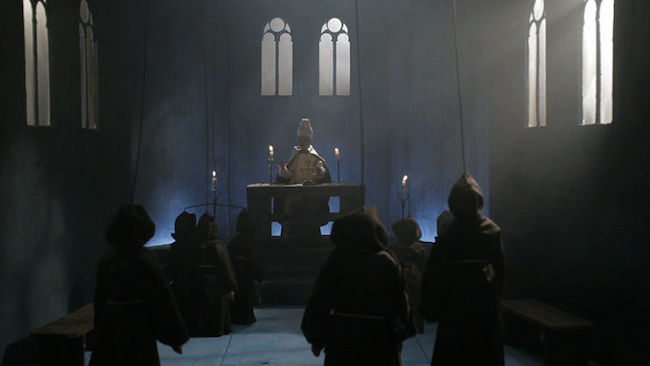Recontextualizing historical events within fiction or art often offers audiences the opportunity to re-evaluate their thoughts and attitudes regarding that history. Events we would otherwise file away are revisited; our approach to them is skewed slightly, allowing us to see the familiar with a fresh set of eyes. The pain in Maus or the absurd horror of the Holy Mountain’s “Great Toad and Chameleon Circus” give us another approach to connect with historical events which we may otherwise assume are too far in the past or of too large a scale to grasp.

Clay marionettes from “Cabaret Crusades” by Wael Shawky. Photographs courtesy of the artist and MoMA. Click to see a larger image.
The Crusades are a perfect subject for this treatment. Egyptian artist Wael Shawky, in his exhibition Cabaret Crusades (Jan. 31 – Sept. 7, MoMA PS1, New York) uses glass and clay marionettes to retell the story of the Crusades in a series of films. More than that, he draws primarily from Arabic historians in the retelling. In trying to make an engaging but not necessarily entertaining film, Shawky found parallels in contemporary politics that appear to be echoes of events that happened about 1,000 years ago. He goes into more detail in the Blouin ArtInfo interview embedded below.
From MoMA:
“For his first solo exhibition at a major American museum, Wael Shawky presents his epic video trilogy that recounts the history of The Crusades from an Arab perspective. Inspired by The Crusades Through Arab Eyes by Lebanese historian Amin Maalouf, Shawky’s videos chart the numerous European campaigns to the Holy Land, starting from the early Crusades from 1096–1099 A.D. that are depicted in CABARET CRUSADES: THE HORROR SHOW FILES (2010) and the First and Second Crusades from 1099–1145 A.D. in CABARET CRUSADES: THE PATH TO CAIRO (2012). The MoMA PS1 exhibition will feature both works and debut the third and final video from the series, CABARET CRUSADES: THE SECRETS of KARBALA.
“Based on accounts from primary sources, Shawky complicates the traditional civilization clash narrative by describing scenes that refute common notions of the era. Shawky highlights both the secular motivations of the European fighters and the competition and violence among Arab leaders. Using 200-year-old marionettes from a collection in Italy for the first installment, and custom-made ceramic figures for the second, Shawky says the puppets help create a ‘surreal and mythical atmosphere that blends drama and cynicism, telling a story of remote events that could hardly be more topical today. The puppets’ strings clearly refer to the idea of control. The work also implies a criticism of the way history has been written and manipulated.'”
What do you think of Wael Shawky’s clay marionettes? Share your comments below!

Clay marionettes from “Cabaret Crusades” by Wael Shawky. Photographs courtesy of the artist and MoMA.

Clay marionettes from “Cabaret Crusades” by Wael Shawky. Photographs courtesy of the artist and MoMA. Click to see a larger image.

Clay marionettes from “Cabaret Crusades” by Wael Shawky. Photographs courtesy of the artist and MoMA.

Clay marionette from “Cabaret Crusades” by Wael Shawky. Photographs courtesy of the artist and MoMA.

Add your valued opinion to this post.